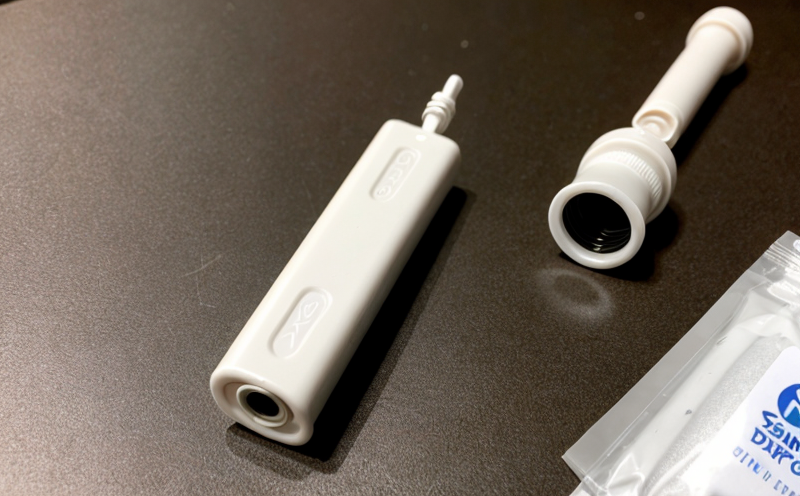Disposable Surgical Blade Sharpness Testing
The testing of disposable surgical blades is a critical aspect of ensuring patient safety and compliance with international standards. Precision and reliability in these blades are paramount, especially given the high stakes involved in surgical procedures.
In the medical device sector, particularly for single-use devices like surgical blades, sharpness is a key performance indicator (KPI) that directly impacts the success of surgical interventions. A dull blade can lead to increased risk of infection, prolonged surgery time, and suboptimal surgical outcomes. Therefore, ensuring consistent and accurate measurement of blade sharpness becomes essential.
Sharpness testing involves evaluating various parameters such as edge angle, surface roughness, and geometric precision. The ISO 13485:2016 standard outlines the requirements for quality management systems in medical device manufacturing, which includes stringent guidelines for product testing like blade sharpness. Compliance with these standards is not only a regulatory requirement but also an assurance to healthcare providers and patients.
From a practical standpoint, testing involves using specialized instruments designed to measure the edge angle of surgical blades accurately. These devices typically employ laser or mechanical methods to capture precise measurements. The results are compared against predetermined acceptance criteria set by the manufacturer or regulatory bodies. Understanding these parameters is crucial for quality managers and R&D engineers involved in the design and manufacturing process.
The importance of sharpness testing extends beyond mere compliance; it also aids in product optimization. By identifying edge imperfections early, manufacturers can refine their production processes to enhance blade performance. This not only improves patient outcomes but also reduces the incidence of adverse events post-surgery. Compliance officers play a vital role in ensuring that these tests are conducted consistently across all batches.
Moreover, sharpness testing is an integral part of the quality assurance (QA) and quality control (QC) processes within medical device manufacturing facilities. It helps in maintaining high standards of product integrity and reliability, which are essential for patient safety. The QA/QC teams rely on accurate and repeatable test results to make informed decisions about process improvements and product release.
In summary, sharpness testing is a critical step in ensuring the quality and safety of surgical blades used in medical procedures. By adhering to stringent testing protocols and leveraging advanced instrumentation, manufacturers can deliver reliable products that meet regulatory standards and enhance patient care.
Why It Matters
Sharpness is a critical factor in the performance of surgical blades. A dull blade can lead to increased tissue damage during surgery, prolonging recovery times and increasing the risk of infection. Infection rates are directly linked to the sharpness of the blade used during procedures.
- Increase in Tissue Damage: Dull blades tear through tissues rather than cutting cleanly, leading to excessive bleeding and tissue damage.
- Prolonged Surgery Time: The need for multiple attempts with a dull blade increases the duration of surgery, which can be detrimental to patient recovery.
- Increased Risk of Infection: Torn tissues are more susceptible to bacterial invasion, leading to higher infection rates and prolonged hospital stays.
The importance of sharpness testing cannot be overstated. It ensures that only high-quality blades reach the operating room, thereby enhancing patient safety and surgical outcomes. Compliance with international standards like ISO 13485:2016 is crucial in maintaining these high standards.
Scope and Methodology
The scope of sharpness testing for disposable surgical blades includes evaluating the edge angle, surface roughness, and geometric precision. The methodology involves using specialized instruments that can measure these parameters accurately. These instruments typically employ laser or mechanical methods to capture precise measurements.
The first step in the testing process is specimen preparation. This involves ensuring that each blade is in its original packaging and free from any external contaminants. Once prepared, the blades are placed into the instrument for measurement. The edge angle is a critical parameter; it is measured using high-resolution laser scanners or mechanical gages.
Surface roughness is another important factor. This is evaluated by assessing the micro-roughness of the blade's surface to ensure that it meets the required standards. Geometric precision, including the straightness and parallelism of the edge, is also assessed to ensure that each blade performs consistently across all cuts.
The results are compared against predetermined acceptance criteria set by the manufacturer or regulatory bodies. Compliance with these criteria ensures that only blades meeting high quality standards are released for use in surgeries. This process helps maintain consistent performance and reliability across all products.
Use Cases and Application Examples
- Cutting Tissue: In open surgical procedures, sharp blades ensure clean cuts that minimize tissue damage and reduce the risk of infection.
- Dissecting Blood Vessels: Sharp blades are essential for safely dissecting blood vessels without causing excessive bleeding or tearing.
- Incising Skin Layers: During deep incisions, a sharp blade ensures that only the desired layer is cut, minimizing damage to surrounding tissues.
- Suturing Preparation: Prior to suturing, sharp blades are used to create precise and clean edges for better suture retention.
- Minimally Invasive Procedures: In laparoscopic surgeries, the sharpness of the blade is crucial as it must cut through layers without causing damage to surrounding tissues.
- Cataract Surgery: For precise and delicate procedures like cataract surgery, blade sharpness ensures that only the necessary tissue is removed without affecting adjacent areas.
In all these use cases, ensuring consistent sharpness testing is essential. It not only enhances surgical precision but also contributes to patient safety and satisfaction.





